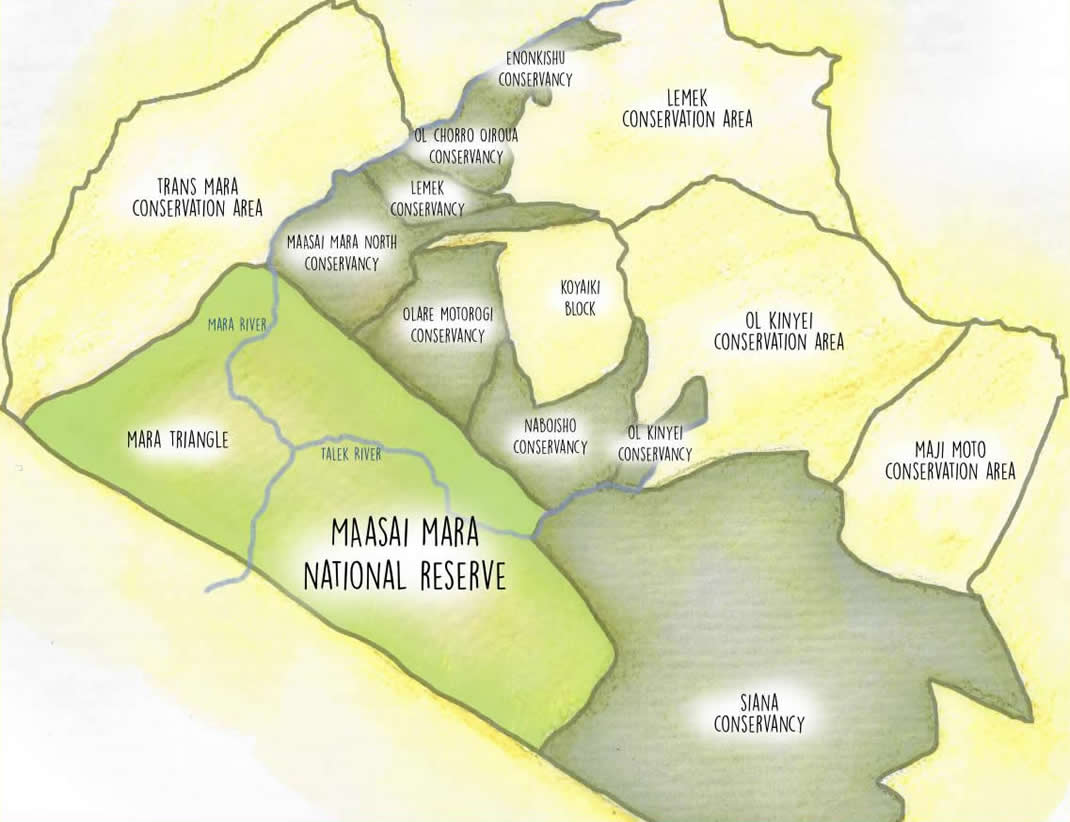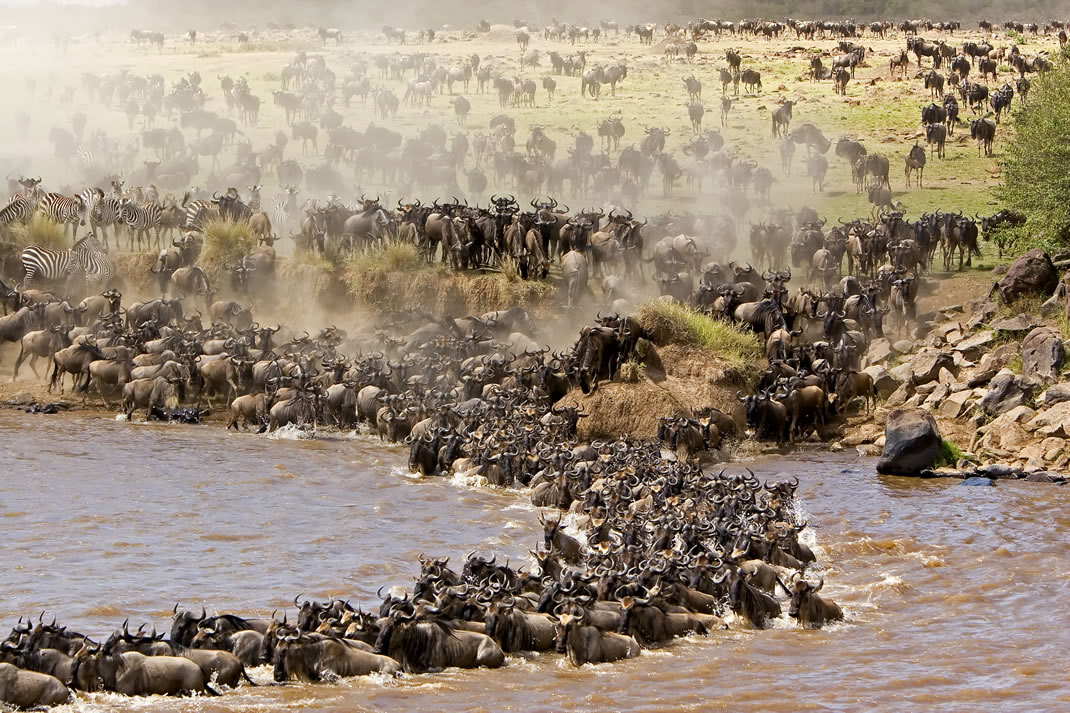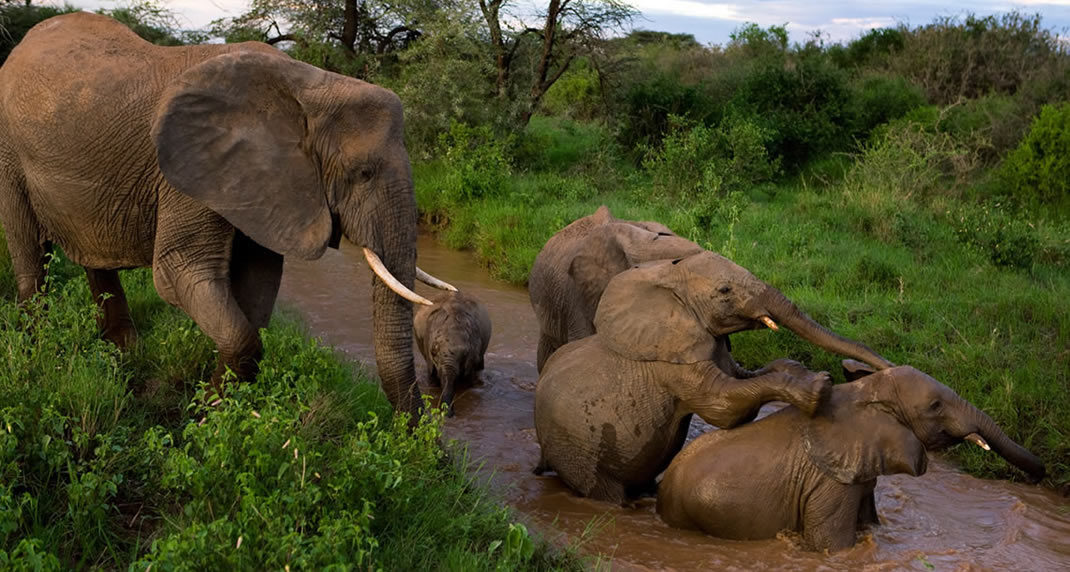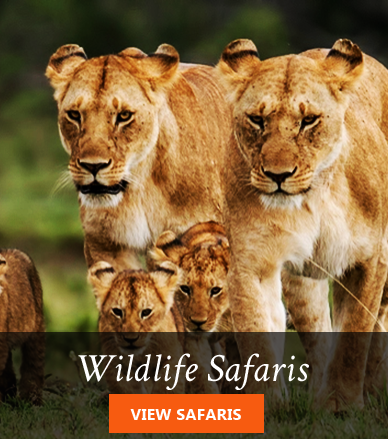The Wikipedia, one of the most respected free online encyclopedia, describes the Masai Mara as ‘a large game reserve in Narok County, Kenya, contiguous with the Serengeti National Park in Mara Region, Tanzania’ .
That is not all Wikipedia says. The online page goes on: ‘It is globally famous for its exceptional population of lions, leopards and cheetahs, and the annual migration of zebra, Thomson’s gazelle, and wildebeest to and from the Serengeti every year from July to October, known as the Great Migration’
So, what do you know about the Masai Mara and Safaris to Masai Mara?
The Mara National Reserve, The Mara Triangle and The Conservancies
Table of Contents
The first 3 paragraphs of this article outline the basics of understanding the the world-famous Masai Mara. The Mara region is made up of the original central run reserve, set aside for wild animals in 1961. This is the section referred to as Masai Mara National Park. Within this original and government-run reserve, we have Mara Triangle – a crown jewel of sorts. Outside national park and the Mara Triangle, there are the private wildlife conservancies. There are adjacent to the main reserve.
The Masai Mara National Reserve
The Masai Mara National Reserve is just a fraction of the Greater Mara Ecosystem. It was first established in 1961 as a wildlife sanctuary. At that time, the area covered only 520 square kilometres (200 square miles).
The wildlife sanctuary was later extended to 1821 square kilometres and then converted to a game reserve. Part of the game reserve was given National Reserve status in 1974, and the remaining area of 159 square kilometres (61 square miles) was returned to local communities. An additional 162 square kilometres (63 square miles) were removed from the reserve in 1976, and the park was reduced to 1,510 km2 (580 sq miles).
The National reserve is owned and managed by the local government – Narok County. The income generated from tourist activities is collected by the local government. The more visited eastern part of the park is managed by Narok County Council and the western part, known as the Mara Triangle, by the Mara Conservancy a local nonprofit organization formed by the local Maasai that contains several anti-poaching units.
The Mara Triangle
The Mara Triangle is considered the prime safari area within the larger Masai Mara National Reserve. The area is triangular in shape. This area covers about one third of the entire Masai Mara Reserve. It is not a private conservancy though, as most of its are is part of the main reserve.
The area lies on the western side to the reserve where the Mara River forms a natural boundary. The other boundary is defined by the Oloololo escarpment (Siria). The area under Mara triangle is about 126,023 acres and is managed by Mara Conservancy, a non-profit organization.
The location of the Mara Triangle makes it ideal for safaris. Whereas the wild animals are free to wander between the neighbouring wilderness, the Mara River, acting as a natural fence, ensures the animals stay within the Mara Triangle. For those who would like to witness the wildebeest migration, the Mara triangle is a perfect place to stay. It is the entrance point of the wildebeest when they arrive from the Serengeti. It is also the exit point when the animals migrate back to Serengeti.
Safari Lodges Located Inside The Mara Triangle
There are only 2 safari accommodations inside the Mara Triangle – Little Governors Camp and Mara Serena Lodge. Guests staying in any of these 2 safari lodges do their game drives inside the triangle.
There are other safari lodges and camps that are not located inside the Mara Triangle, but are close enough to do safari game drives here. These include Angama Mara, Mara Engai Wilderness camp, Mara River Camp, andbeyond Kichwa Tembo Camp, andbeyond Beteleur Camp, and Sanctuary Olonana. Others are Kilima Camp, Mara Siria Camp, Mpata Camp and a few others.
Wildlife Conservancies Within The Greater Masai Mara Ecosystem
Apart from the state-run original park, the Masai Mara area, there is a large area to the north of the reserve. Some of this vast area has been set aside for wildlife Conservation of the habitat adjacent to the Mara Reserve. These are the parts that form private conservancies. These are areas with strict control on the number of visitors and safari vehicles permitted.

The private conservancies in the Mara allow only a small number of safari camps within them such that guests staying within the conservancies gain almost exclusive access to the large areas of prime game viewing. Whereas The Maasai Mara National Reserve is owned and managed by a local government authority, these private conservancies belong to the local land owners. The income generated through tourism goes directly to these landowners
Today, 15 wildlife conservancies have been established in areas surrounding the National Reserve. Though they are all unique in natural habitat, size, and structure, all share in the philosophy that both wildlife and local people to thrive.
Siana Conservancy
Siana Conservancy covers 10,000 acres and is a partnership between 1,517 landowners and 15 tourism camps.
The Pardamat Conservancy Area
It is adjacent to Naboisho, Olkinyei, Lemek and Mara North conservancies and serves as a migration route from the Loita plains that connects the four established conservancies to the Mara Triangle and then to the Maasai Mara National Reserve.
Oloisukut Conservancy
Covers 23,000 acres and is a partnership between 65 landowners and 2 tourism camps.
Olderkesi Conservancy
Adjacent to the southeast corner of the Maasai Mara National Reserve, just north of Tanzania’s Serengeti National Park. The conservancy is managed by two trusts: Cottar’s Wildlife Conservancy Trust and Olderkesi Wildlife Community Trust. It is owned by the Maasai, who are the OWCT, but it is rented by Cottar’s Wildlife Conservancy Trust.
Ol Kinyei Conservancy
Covers an area of 18, 641 acres. The conservancy is a partnership between 177 local private landowners and four tourism parties. It is home to a wide variety of wildlife including resident prides of lions, leopards and numerous other animals as well as over 300 species of bird.
Olchorro Oirowua Conservancy
Olchorro covers 15,765 acres and is a partnership between 170 landowners and 4 safari camps.
Olarro North and South Conservancies
Together, the 2 cover 24,500 acres and are a partnership between 2,200 landowners and 2 safari camps.
Olare Motorogi Conservancy
Covers an approximate area of 33, 386 acres and is a strategic buffer zone for the Maasai Mara National Reserve and key wildlife migration corridors. Built upon a partnership with 288 landowners
Nashulai Conservancy
Protects a critical migratory corridor and wild elephant nursery. It covers 6,000 acres and has 71 landowners.
The Mara North Conservancy
A stunning wilderness area of 69,160 acres. It’s the largest conservancy and a vital part of the Maasai Mara ecosystem as it forms the north-western zone, bordering the Maasai Mara National Reserve. The Conservancy is a partnership between 14 safari camps and 666 landowners.
Mara North is one of the most populated wildlife areas within the Maasai Mara. It is home to the Leopard Gorge, a vital birthing and maternity ground for the big cats, as well as the scenic Lemek Hills, an important refuge to highly threatened African wild dogs. During the Loita Hills migration (December to May), thousands of local wildebeest come to the Mara North Conservancy.
Mara Naboisho conservancy
Made up of more than 52,000 acres made up of land contributions from 636 landowners. Located adjacent to the Maasai Mara National Reserve, it is home to the big cats – in impressive numbers – and herds of elephant, giraffe, and wildebeest. The density of lions within Naboisho is one of the highest in the world, with a population of more than 70 identified lions who use Naboisho as their home territory.
Lemek conservancy
Covering 6,027 acres with 480 landowners, Lemek Conservancy is one of the high wildlife density areas with Great Plains offering pleasant scenery and best wildlife viewing areas of the Maasai Mara ecosystem. It is home to the big cats namely Lions, Leopards and Cheetahs and occasionally large herds of Elephants can be spotted. Others include Hippo, Warthog, Buffalo, and several species of Antelope, and numerous bird species.
Enonkishu Conservancy
Situated on the northern most point of the Greater Mara Ecosystem covering an area of 5,928 acres, 2 tourism partners and 42 landowners. The main focus of the conservancy is livestock improvement through innovative cattle management programs, running alongside novel tourism projects.
The Annual Great Migration In Masai Mara National Park
If there is only one thing that is synonymous with Masai Mara, that would have to be the migration of thousands of animals – wildebeest, antelopes and Zebra. During the time between July and October, these herds migrate from the Serengeti to the Mara in search of good and water. During this period the Mara is dotted black by what is estimated to be over 2 millions animals. The migration at Masai Mara is one of the largest multi-species migrations, where the animals cross the mighty Mara River to the other side.

Nowhere in the world is there a movement of animals as immersing as the wildebeest migration, herds migrate from the Serengeti National Park in Tanzania to the greener pastures of the Maasai Mara National Reserve. From August the wildebeest herds begin moving faster in search of water and greener grass, making their way across the Grumeti and Mara River. October is a good time to see the wildebeest herds move back into the Serengeti and warm weather can be expected. A short migration safari in Kenya or a trip combining Kenya and Tanzania is a good way to witness the migration spectacle.
The Wildlife of Masai Mara
The Mara is known as one of the finest wildlife destinations in the World. There is an excellent chance of seeing the Big 5, cheetah, serval, hyena, bat-eared foxes, black-backed and side-striped jackals, hippo, crocodile, baboons, warthog, topi, eland, Thompson’s gazelle, Grant’s gazelle, impala, water buck, oribi, reed-buck, zebra.
Climate And Weather In Maasai Mara
The Masai Mara is at an altitude of 1,600 metres (5300 feet). Temperatures range from a minimum of 20°C to a maximum of to 30°C. Mornings are often sunny in the Mara. Clouds build up in the afternoons during the rainy season, with thunderstorms in the afternoon till evening. The dry season is from June-November.
Airstrips in Masai Mara
There are several airstrips within the Mara that serve guests visiting the park.
Within the National Reserve Area – Mara Serena Airstrip, Musiara Airstrip and Keekorok Airstrip.
Within the Various Conservancies – The other airstrips, Mara Shikar Airstrip, Kichwa Tembo Airstrip and Ngerende Airstrip.
Safari Activities in Maasai Mara
For a regular safari, game drives are the main activity. Game drives are the most popular safari activities in Masai Mara, and with good reason. A vehicle easily navigates the varied and distant terrain.
Game drives can be taken either be taken in closed side safari jeeps or open safari vehicles or safari vans. It depends on your package. In all case, there will be a driver, whose is also the guide. Most driver-guides have the experience and knowledge about the wildlife and the ecological aspects of Masai Mara.
Game Drives normally start early in the morning or in the late afternoon when it is cooler. This is the time when the predators go hunting for the grazers. There is a better chance of seeing both the hunters and the hunted.
Some safari camps offer night game drives that will allow you to witness fascinating nocturnal Animals. This is only possible for camps and lodges that are located in conservancies. Those within the Mara reserve are not allowed to offer night game drives. Some safari camps and lodges that offer night game drives are Kilima Camp, Olare Mara Kempinski, Karen Blixen Camp and a few others more.
All game drives are undertaken in an open safari vehicle, with a driver / guide who has extensive experience and intimate knowledge of the area, and is an expert on game movement and other ecological aspects of the region. Game drives usually depart in the early morning and late afternoon
Another way to enjoy the safaris in Masai Mara is to take on the bush walk, referred to as nature walk. It is simply taking a safari on foot – Walking safari.
Just like the night game drive, the walking safari is not normally allowed in the national reserves. In Masai Mara, it is only possible to do this if you are staying a a lodge or safari camp in one of the conservancies. But there is no better way of enjoying the safari than doing this on foot. Walking safaris inspire a degree of respect for the wild environment, as you soon realize that you are a participant and not just a spectator. Guided bush walks or nature walks may last as little as one hour or extend into half the day. Your walking safari guide will be helping you find and identify tiny creatures of the African wilderness. He will be teaching you tracking techniques as you discover how to differentiate types of animal footprints and dung!
Other exciting activities you may take while on safari in Masai Mara include; horse-back safaris, and hot air ballooning. One can also visit an authentic Masai village while on safari.
Accommodation – Places You Can Stay While on Masai Mara Safari
Safari accommodation in Massai Mara is either in concrete wall lodges or safari tents. The number of concrete-wall lodges is countable. The vast majority of safari accommodation in Masi mara will be in canvas tented camps. But being tented does not take anything away from their luxurious qualities. The tented camps are mostly have en suite facilities and some even have their own private plunge pool!
The locations of most safari camps in the Mara are all tactically placed so they have great game-viewing opportunities all year round and their relatively small size means you will receive a personal and intimate experience.
Select Top Luxury Camps and Lodges in Masai Mara
Angama Camp, Pahali Mzuri, Sand River Mara Camp, Cottars 1920s Camp,
Select Mid-Range Camps and Lodges
Mara Serena Lodge, Sand Rivers, andbeyond Kichwa Tembo, andbeyond Bateleur, Ashnil Mara Camp
Select Comfort Level Camps in Mara
Mara River Camp, Mara Engai Camp, Mara Simba Lodge, Keekorok Lodge, Sarova Mara Camp.
Select Low Budget Camps and Lodges
Ol Moran Tented camp, Lanchada Camp, Mara Sidai Camp,
Best Time To Visit Maasai Mara,
The Masai Mara is an all year round destination. Forgive the cliché.
Having said that, some ‘safari experts’ insist that the best time to visit the Masai mara is between July and October. This largely due to the obsession with the Wildebeest migration that takes place around the said period. Fascinating as it may be, the migration spectacle is not the only reason one should consider a safari to Masai Mara. During the rest of the year, before and after the migration, all the big game is still in the Mara. The wet season might not be the best as the vegetation is tall and might not be optimal for game viewing.
Masai Mara Park Entry Rates and Fees
Park fees and conservancy fees are paid for entry in the park and the conservancies. Each person, above the age of 18 years is considered an adult and pays the adult rates. Non residents visiting the park and conservancies pay the fees in US Dollars. Citizens of Kenya and East Africa, and non-citizens of Kenya who reside in country pay the fees in Kenya Shillings.
Non-Residents
Non Resident Adults Inside the park – US$ 70
Non Resident outside the park – US$ 80
Non Resident Children inside the park – US$ 40
Non Resident Children outside the park -US$ 45
Non Resident Student Adult – US$ 40
Non Resident Student Children – US$ 20
East African Citizens
Citizen Adults – Ksh. 1000
Citizen Children – Ksh. 200
Citizen Student – Ksh. 200
East African Citizens
Resident Adult – Ksh 1,200
Resident Children – Ksh 300
Resident Student – Ksh 300
You can plan your safari to Masai Mara with you preferred Travel Agent or Tour Operator. You could also contact Hallmark Travel Planners to plan your trip.




Leave a Reply